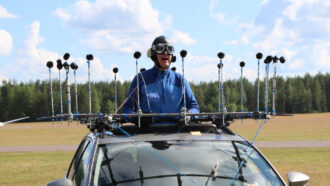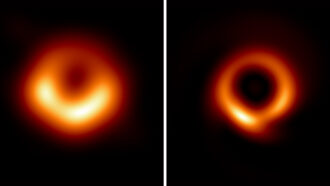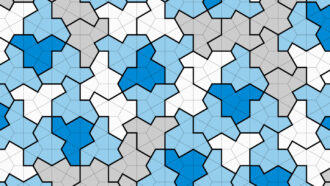
Physics writer Emily Conover joined Science News in 2016. She has a Ph.D. in physics from the University of Chicago, where she studied the weird ways of neutrinos, tiny elementary particles that can zip straight through the Earth. She got her first taste of science writing as a AAAS Mass Media Fellow for the Milwaukee Journal Sentinel. She has previously written for Science Magazine and the American Physical Society. She is a two-time winner of the D.C. Science Writers’ Association Newsbrief award.

Trustworthy journalism comes at a price.
Scientists and journalists share a core belief in questioning, observing and verifying to reach the truth. Science News reports on crucial research and discovery across science disciplines. We need your financial support to make it happen – every contribution makes a difference.
All Stories by Emily Conover
-
 Physics
PhysicsScience explains why shouting into the wind seems futile
Sending a sound upwind, against the flow of air, makes the sound louder due to an acoustical effect called convective amplification. Sound sent downwind is quieter.
-
 Physics
PhysicsThese worms can escape tangled blobs in an instant. Here’s how
Tangled masses of California blackworms form over minutes but untangle in tens of milliseconds. Now scientists know how.
-
 Quantum Physics
Quantum PhysicsA sapphire Schrödinger’s cat shows that quantum effects can scale up
The atoms in a piece of sapphire oscillate in two directions at once, a mimic of the hypothetically dead-and-alive feline.
-
 Astronomy
AstronomyThe first black hole portrait got sharper thanks to machine learning
A machine learning technique filled in data gaps in the image of M87’s black hole, resulting in a thinner ring.
-
 Math
MathMathematicians have finally discovered an elusive ‘einstein’ tile
After half a century, mathematicians succeed in finding an ‘einstein,’ a shape that forms a tiled pattern that never repeats.
-
 Astronomy
AstronomyThe mystery of Christiaan Huygens’ flawed telescopes may have been solved
The discovery of Saturn’s largest moon, Titan, may have come despite its discoverer, Christiaan Huygens, needing eyeglasses.
-
 Physics
PhysicsIs this the superconductor of scientists’ dreams? A new claim faces scrutiny
It’s big, if true: transmitting electricity with no resistance at room temperature and moderate pressure. But controversy dogs the team making the claim.
-
 Particle Physics
Particle PhysicsMuons unveiled new details about a void in Egypt’s Great Pyramid
The subatomic particles revealed the dimensions of the void, discovered in 2016, and helped researchers know where to stick a camera inside.
-
 Physics
PhysicsThe standard model of particle physics passed one of its strictest tests yet
An experiment with a single electron, trapped for months on end, produced one of the most precise tests yet of the standard model of particle physics.
-
 Quantum Physics
Quantum PhysicsGoogle’s quantum computer reached an error-correcting milestone
A larger array of quantum bits outperformed a smaller one in tests performed by Google researchers, suggesting quantum computers could be scaled up.
-
 Physics
PhysicsHere’s why icicles made from pure water don’t form ripples
A new study explains why icicles made from pure water have irregular shapes rather than the ripples typical of the salty icicles found in nature.
-
 Physics
PhysicsWater is weird. A new type of ice could help us understand why
A newfound type of amorphous ice with a density close to liquid water could help scientists make sense of water’s quirks.